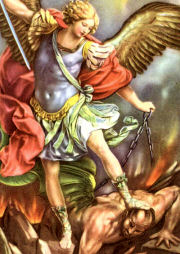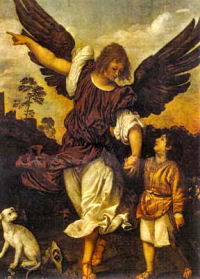 |
| Thérèse in July 1896 |
"I prefer the monotony of obscure sacrifice to all ecstasies. To pick up a pin for love can convert a soul." These are the words of Theresa of the Child Jesus, a Carmelite nun called the "Little Flower," who lived a cloistered life of obscurity in the convent of Lisieux, France. [In French-speaking areas, she is known as Thérèse of Lisieux.] And her preference for hidden sacrifice did indeed convert souls. Few saints of God are more popular than this young nun. Her autobiography, The Story of a Soul, is read and loved throughout the world. Thérèse Martin entered the convent at the age of 15 and died in 1897 at the age of 24.
Life in a Carmelite convent is indeed uneventful and consists mainly of prayer and hard domestic work. But Thérèse possessed that holy insight that redeems the time, however dull that time may be. She saw in quiet suffering redemptive suffering, suffering that was indeed her apostolate. Thérèse said she came to the Carmel convent "to save souls and pray for priests." And shortly before she died, she wrote: "I want to spend my heaven doing good on earth."
On October 19, 1997, Pope John Paul II proclaimed her a Doctor of the Church, the third woman to be so recognized in light of her holiness and the influence of her teaching on spirituality in the Church.
St. Thérèse is known today because of her spiritual memoir, L'histoire d'une âme (The Story of a Soul), which she wrote upon the orders of two prioresses of her monastery, and because of the many miracles worked at her intercession. She began to write "Story of a Soul" in 1895 as a memoir of her childhood, under instructions from her sister Pauline, known in religion as Mother Agnes of Jesus. Mother Agnes gave the order after being prompted by their eldest sister, Sister Marie of the Sacred Heart. While Thérèse was on retreat in September 1896, she wrote a letter to Sister Marie of the Sacred Heart which also forms part of what was later published as "Story of a Soul." In June 1897, Mother Agnes became aware of the seriousness of Thérèse's illness; she immediately asked Mother Marie de Gonzague, who had succeeded her as prioress, to allow Thérèse to write another memoir with more details of her religious life. With selections from Therese's letters and poems and reminiscences of her by the other nuns, it was published posthumously. It was heavily edited by Pauline (Mother Agnes), who made more than seven thousand revisions to Therese's manuscript and presented it as a biography of her sister. (Aside from considerations of style, Mother Marie de Gonzague had ordered Pauline to alter the first two sections of the manuscript to make them appear as if they were addressed to Mother Marie as well).
 |
| Link to Amazon.com |
Since 1973, two centenary editions of Thérèse's original, unedited manuscripts, including The Story of a Soul, her letters, poems, prayers and the plays she wrote for the monastery recreations have been published in French. ICS Publications has issued a complete critical edition of her writings: Story of a Soul, Last Conversations, and the two volumes of her letters were translated by John Clarke, O.C.D.; The Poetry of Saint Thérèse by Donald Kinney, O.C.D.; The Prayers of St. Thérèse by Alethea Kane, O.C.D.; and The Religious Plays of St. Therese of Lisieux by David Dwyer and Susan Conroy.
Free Kindle Editions:
Free Kindle Editions:
The Story of a Soul (L'Histoire d'une Âme): The Autobiography of St. Thérèse of Lisieux With Additional Writings and Sayings of St. Thérèse [Kindle Edition]
de Lisieux Thérèse (Author), Thomas N. (Thomas Nimmo) Taylor (Illustrator, Translator)The Life of St. Teresa of Jesus [Kindle Edition]
of Avila Teresa (Author) |
asVeronica's veil, by Claude Mellan c. 1649.
St. Thérèse wore an image of the Holy Face
on her heart.
Comment:
Thérèse has much to teach our age of the image, the appearance, the "sell." We have become a dangerously self-conscious people, painfully aware of the need to be fulfilled, yet knowing we are not. Thérèse, like so many saints, sought to serve others, to do something outside herself, to forget herself in quiet acts of love. She is one of the great examples of the gospel paradox that we gain our life by losing it, and that the seed that falls to the ground must die in order to live (see John 12).
Preoccupation with self separates modern men and women from God, from their fellow human beings and ultimately from themselves. We must relearn to forget ourselves, to contemplate a God who draws us out of ourselves and to serve others as the ultimate expression of selfhood. These are the insights of St. Thérèse of Lisieux, and they are more valid today than ever.
Thérèse has much to teach our age of the image, the appearance, the "sell." We have become a dangerously self-conscious people, painfully aware of the need to be fulfilled, yet knowing we are not. Thérèse, like so many saints, sought to serve others, to do something outside herself, to forget herself in quiet acts of love. She is one of the great examples of the gospel paradox that we gain our life by losing it, and that the seed that falls to the ground must die in order to live (see John 12).
Preoccupation with self separates modern men and women from God, from their fellow human beings and ultimately from themselves. We must relearn to forget ourselves, to contemplate a God who draws us out of ourselves and to serve others as the ultimate expression of selfhood. These are the insights of St. Thérèse of Lisieux, and they are more valid today than ever.
Quote:
All her life St. Thérèse suffered from illness. As a young girl she underwent a three-month malady characterized by violent crises, extended delirium and prolonged fainting spells. Afterwards she was ever frail and yet she worked hard in the laundry and refectory of the convent.
Psychologically, she endured prolonged periods of darkness when the light of faith seemed all but extinguished. The last year of her life she slowly wasted away from tuberculosis. And yet shortly before her death on September 30 she murmured, "I would not suffer less."
Truly she was a valiant woman who did not whimper about her illnesses and anxieties. Here was a person who saw the power of love, that divine alchemy which can change everything, including weakness and illness, into service and redemptive power for others. Is it any wonder that she is patroness of the missions? Who else but those who embrace suffering with their love really convert the world?
Truly she was a valiant woman who did not whimper about her illnesses and anxieties. Here was a person who saw the power of love, that divine alchemy which can change everything, including weakness and illness, into service and redemptive power for others. Is it any wonder that she is patroness of the missions? Who else but those who embrace suffering with their love really convert the world?
 |
St. Therese of Lisieux PrayingArt Print by Nat Ewert on Etsy.com |





 Our knowledge of the Archangel Raphael comes to us from the book of Tobit. His mission as wonderful healer and fellow traveller with the youthful Tobias has caused him to be invoked for journeys and at critical moments in life. Tradition also holds that Raphael is the angel that stirred the waters at the healing sheep pool in Bethesda. His name means "God has healed".
Our knowledge of the Archangel Raphael comes to us from the book of Tobit. His mission as wonderful healer and fellow traveller with the youthful Tobias has caused him to be invoked for journeys and at critical moments in life. Tradition also holds that Raphael is the angel that stirred the waters at the healing sheep pool in Bethesda. His name means "God has healed".








 1. When the time came for their purification according to the law of Moses, they brought him up to Jerusalem to present him to the Lord
1. When the time came for their purification according to the law of Moses, they brought him up to Jerusalem to present him to the Lord 1. When the Magi had departed, behold, an angel of the Lord appeared to Joseph in a dream
1. When the Magi had departed, behold, an angel of the Lord appeared to Joseph in a dream 1. Now his parents went to Jerusalem every year at the feast of the Passover. And when he was twelve years old, they went up according to custom;
1. Now his parents went to Jerusalem every year at the feast of the Passover. And when he was twelve years old, they went up according to custom; 1. So they took Jesus, and he went out, bearing his own cross.
1. So they took Jesus, and he went out, bearing his own cross. 1. And they brought him to the place called Gol'gotha (which means the place of a skull).
1. And they brought him to the place called Gol'gotha (which means the place of a skull). 1. In order to prevent the bodies from remaining on the cross on the sabbath, the Jews asked Pilate that their legs might be broken, and that they might be taken away.
1. In order to prevent the bodies from remaining on the cross on the sabbath, the Jews asked Pilate that their legs might be broken, and that they might be taken away. 1. Joseph took the body, and wrapped it in a clean linen shroud,
1. Joseph took the body, and wrapped it in a clean linen shroud,


